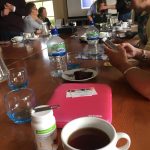
Would you think of a pair of glasses as a mobility aid?
When you see an item every day and used by everyone then it becomes ‘the norm’ and not seen as an aid to support someone with a disability.
There are many products that are designed to support those with disabilities, these include glasses, hearing aids, walking sticks, wheelchairs and even other everyday products like iPhones and iPads.
It may not seem like it to a person who has no sensory or motor disabilities, yet all apple products were designed with accessibility and intergration as their base principle.
There are obviously other computer operating systems, programmes and technologies available. But as a Mac (made famous in a Mitchell & Webb sketch) which I have been ever since I studied at university; way back when Apple Macintosh was for everything design and Windows was for everything administrative.
I have spoken before of my liking for Apple products, and in this I am not alone. Molly from The Molly Watt Trust is a big believer and user of Apple products, her charity have also helped to support and fund those with Ushers Syndrome by funding an Apple Watch programme as she herself had found its features so very beneficial.
As part of an Ushers Social and awareness weekend (The Weekend that almost wasn’t) Molly was going to give a presentation similar to that that she gives to large companies about accessibility and awareness.
Her work as a Keynote speaker and accessibility advisor sees her working alongside Chris from Sigma (https://www.wearesigma.com/) Among others.
Molly explained the way in which she made use of the accessibility on her iPad. She spoke of the obvious ‘voice-over’ and how she didn’t use it, how she found ‘zoom’ and ‘speak screen’ more neneficial to her.
She spoke of how you could set you home button triple click to bring you a list of accessibility options. Including how to use your camera as a magnifier.
These little ‘nuggets’ of information were some that I was aware of and some that I wasn’t.
Since the latest iOS update there was also a rather clever new accessibility feature called ‘smart invert’ this is where the screen and text are inverted in the colours used, but the p have photographs are not……. Savi g confusion with colours when looking at images.
Chris spoke of how accessibility is in the every day, how as I said at the start of this post , “ when something is used and seen every day it becomes the ‘norm’” and how the work he does with Sigma and Molly is about making that a reality.
Molly explained how she found “Hey Siri” a great help; although this was when she realised that another piece of technology she was used stopped the others in the room from heading the response.
You see, Molly wears ReSound hearing aids; hearing aids that stream her iPhone and iPad directly and clearly into her ears. Just as if she were wearing headphones!
Molly’s work has seen her work with ReSound and it is through this work that I have followed her and learnt about the fantastic products that are available.
Molly and the work she does through her company Molly Watt Ltd is paving the way for those with sightless, Ushers and hearing loss.
This masterclass have me some fantastic information to work with, some new connections to talk to and more importantly new friends who enjoy similar struggles to me.
The session was just a snapshot of what Molly and Chris do when talking to big companies, where there is often very rarely anyone with additional needs in the audience.
But it was enough to make me feel confident that accessibility becoming part of ‘the notm’ Could be a reality in the not to far distant future.




